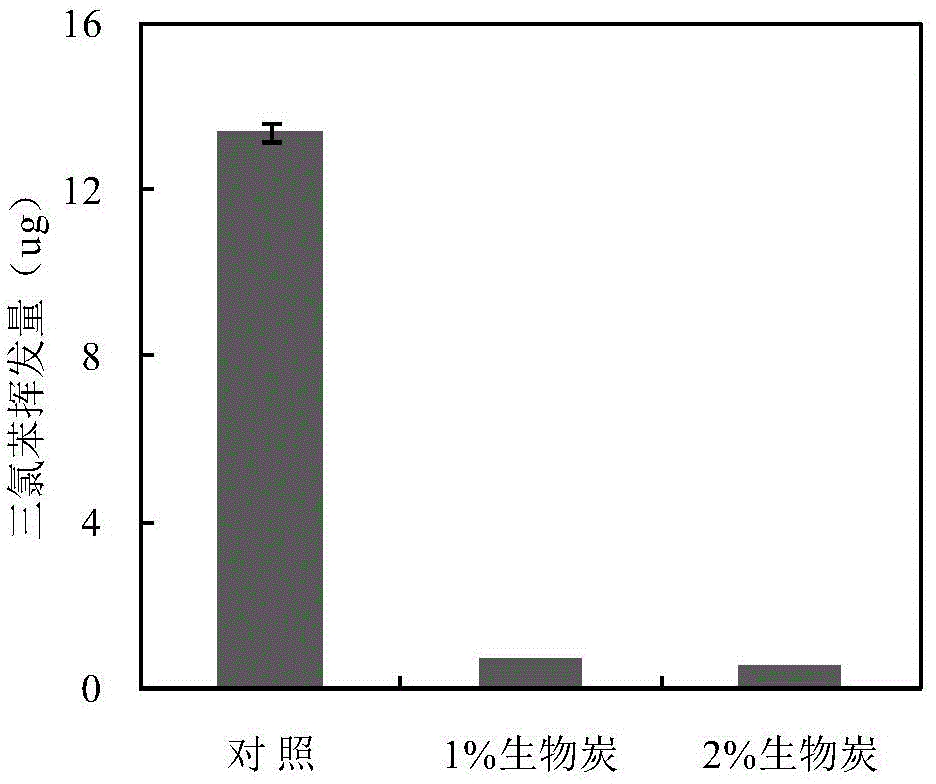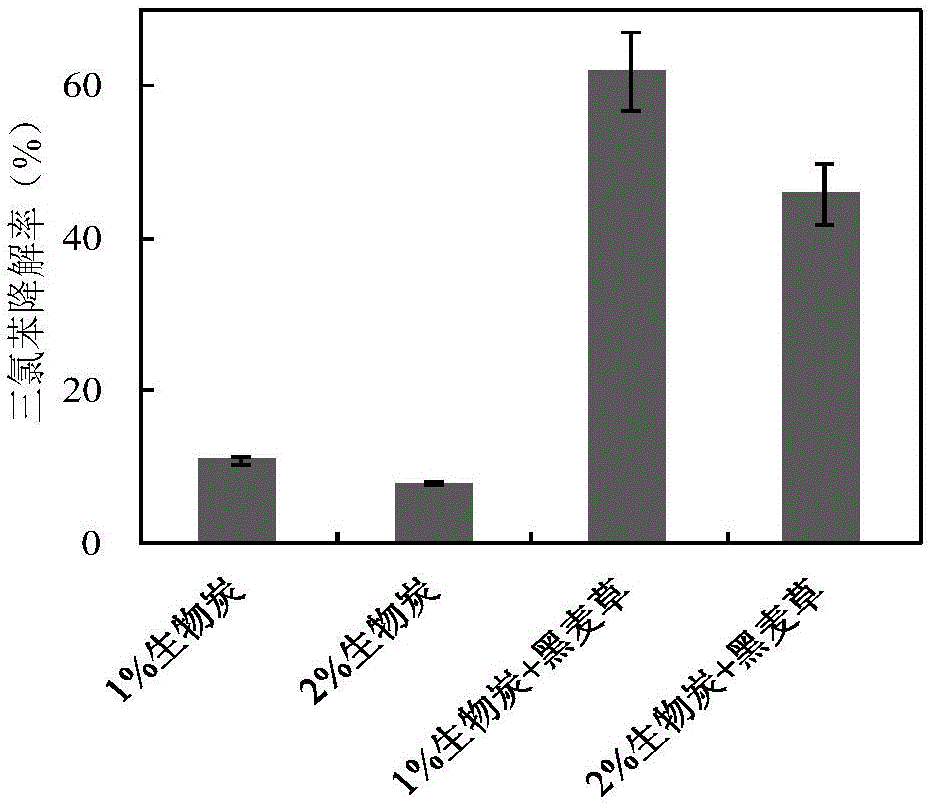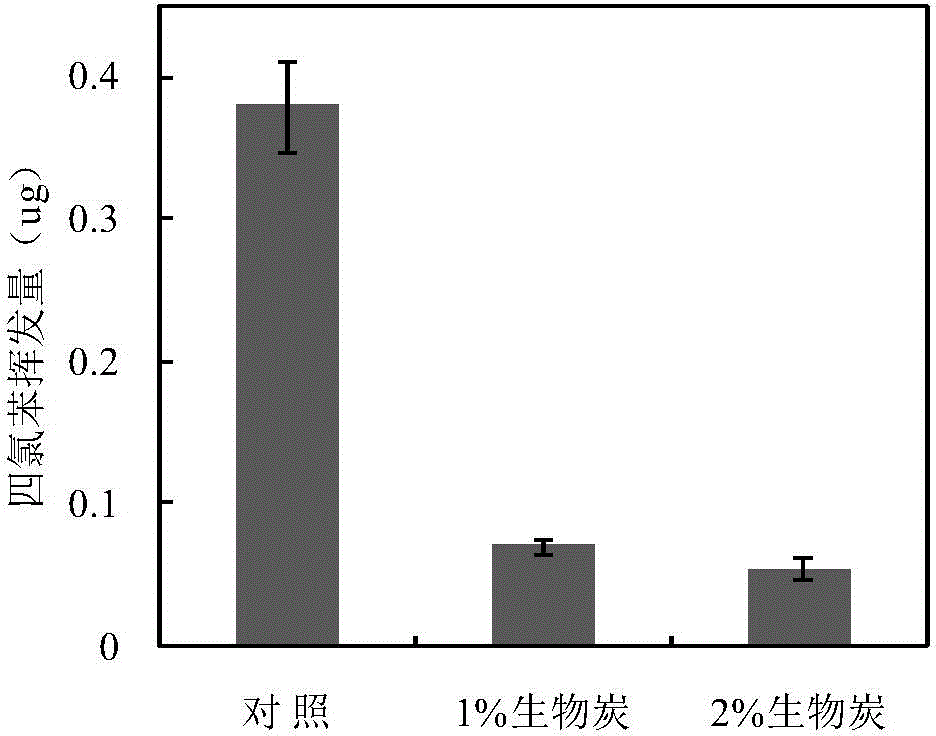Biological carbon-plant joint repairing method of chlorobenzene volatile organic compound-contaminated soil
A technology of volatile organic compounds and polluted soil, which is applied in the field of polluted environment remediation, can solve problems such as polluted soil, achieve the effect of improving soil, increasing fertility and reducing exposure risk
- Summary
- Abstract
- Description
- Claims
- Application Information
AI Technical Summary
Problems solved by technology
Method used
Image
Examples
Embodiment 1
[0032] First prepare biochar, cut wheat straw into broken sections and bake at 80℃ for 12h to dry, then transfer to heating furnace for carbonization, initial furnace temperature is 200℃, program temperature rise to 300℃ then 500℃ and keep for 1.5h , After natural cooling, grinding, and passing through a 0.25mm sieve. The prepared biochar was added to 300g of 1,2,4-trichlorobenzene in an amount of 1% and 2% of the dry weight of the soil, and the concentration was 7μg g. -1 In the contaminated soil, stir and mix thoroughly, then transfer to a 1-L jar, adjust the soil moisture content to 28%, and compact the soil to a density of 1.3g cm -3 , Sealed with rubber plugs with air inlet and outlet, incubate at 25°C in the dark. The treatment without adding biochar was used as a control. Use airtight traps to ventilate each week of the culture, and use n-hexane to trap the volatilized trichlorobenzene. After 4 weeks of culture, such as figure 1 As shown, the volatilization loss of trich...
Embodiment 2
[0034] According to Example 1, biochar was prepared, and then the biochar was added to 300 g of 1,2,4,5-tetrachlorobenzene in an amount of 1% and 2% of the dry weight of the soil, respectively, with a concentration of 1 μg g -1 In the contaminated soil, stir and mix thoroughly, then transfer to a 1-L jar, adjust the soil moisture content to 28%, and compact the soil to a density of 1.3g cm -3 , Seal with rubber plugs with air inlet and outlet, and incubate at 25°C in the dark. The treatment without adding biochar was used as a control. Use airtight traps to ventilate each week of the culture, and use n-hexane to trap the volatilized tetrachlorobenzene. After 4 weeks of culture, such as image 3 As shown, the volatilization loss of tetrachlorobenzene in the treatment with biochar addition was reduced by 81.26% and 85.42%, respectively, compared with the control without addition, which significantly inhibited the volatilization of tetrachlorobenzene from the soil to the atmosphere....
Embodiment 3
[0036] According to Example 1, biochar was prepared, and then the biochar was added to 300g of pentachlorobenzene in an amount of 1% and 2% of the dry weight of the soil to a concentration of 1μg g. -1 In the contaminated soil, stir and mix thoroughly, then transfer to a 1-L jar, adjust the soil moisture content to 28%, and compact the soil to a density of 1.3g cm -3 , Seal with rubber plugs with air inlet and outlet, and incubate at 25°C in the dark. The treatment without adding biochar was used as a control. Use airtight traps to ventilate each week of the culture, and use n-hexane to trap the volatilized pentachlorobenzene. After 4 weeks of culture, such as Figure 5 As shown, the volatilization loss of pentachlorobenzene in the treatment with biochar addition was reduced by 78.57% and 84.43%, respectively, compared with the control without addition, which significantly inhibited the volatilization of pentachlorobenzene from the soil to the atmosphere. Immediately after the a...
PUM
 Login to View More
Login to View More Abstract
Description
Claims
Application Information
 Login to View More
Login to View More - R&D
- Intellectual Property
- Life Sciences
- Materials
- Tech Scout
- Unparalleled Data Quality
- Higher Quality Content
- 60% Fewer Hallucinations
Browse by: Latest US Patents, China's latest patents, Technical Efficacy Thesaurus, Application Domain, Technology Topic, Popular Technical Reports.
© 2025 PatSnap. All rights reserved.Legal|Privacy policy|Modern Slavery Act Transparency Statement|Sitemap|About US| Contact US: help@patsnap.com



